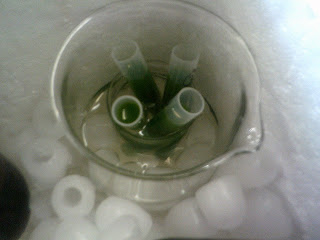We took delivery of centrifuged crushed spinach leaves. They are kept iced so that they last longer away from the plant. There was a solid pellet in the bottom of each tube and a liquid called the supernatant above the pellet. We poured the supernatant into a separate beaker.
Then we added 3 cubic centimetres of isolation medium to the pellet left at the bottom of each tube and gave it a shake. The isolation medium helps to extract the chloroplasts. We called the resultant medium the LEAF EXTRACT.We labelled 5 tubes. We used syringes to measure 5 cubic centimetres of DCPIP into tubes 1, 2, 3 and 5. We used smaller syringes to add 0.5 cubic centimetres of leaf extract to tubes 1, 3 and 4. We wrapped tube 3 in foil. Tube 2 got 0.5 cubic centimetres of isolation medium. Tube 4 got 5 cubic centimetres of distilled water. Tube 5 got 0.5 cubic centimetres of supernatant. We put the tubes 10cm away from a bright light. DCPIP is an electron acceptor.
When light is absorbed by chloroplasts, the energy is used to split water molecules. Two electrons are released. These can be accepted by the DCPIP which loses its colour. Tube 1 is on the left. It is now paler than tube 2. Tube 2 should stay blue because it contains only isolation medium which releases no electrons. Tube 4 is pale green. It contains no DCPIP and is the colour that tube 1 will become when all of the DCPIP has been decoloured. Tube 5 is paler blue/green, showing that the supernatant still contained chloroplasts. The centrifuging hadn't been perfect.
Every 5 minutes we put samples of tubes 1 and 5 into cuvettes for testing in the colorimeter to quantify the colour change.
Tube 3 in the dark stays blue. This shows that the Hill Reaction is indeed the light dependent reaction. No light: no electrons for the DCPIP to accept.





